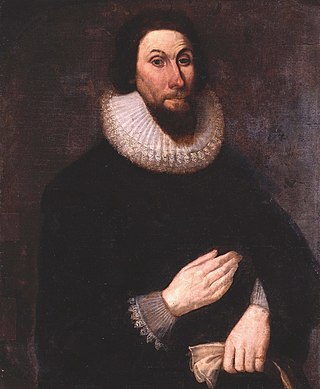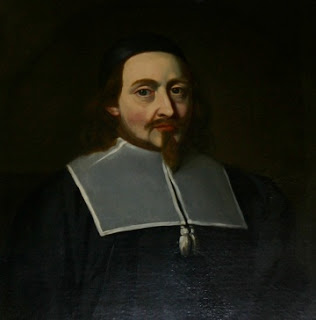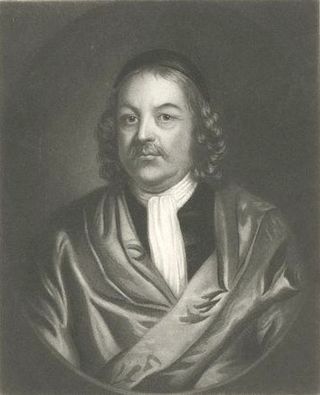
John Winthrop was an English Puritan lawyer and one of the leading figures in founding the Massachusetts Bay Colony, the second major settlement in New England following Plymouth Colony. Winthrop led the first large wave of colonists from England in 1630 and served as governor for 12 of the colony's first 20 years. His writings and vision of the colony as a Puritan "city upon a hill" dominated New England colonial development, influencing the governments and religions of neighboring colonies in addition to those of Massachusetts.

The Massachusetts Bay Colony (1628–1691), more formally the Colony of Massachusetts Bay, was an English settlement on the east coast of North America around the Massachusetts Bay, one of the several colonies later reorganized as the Province of Massachusetts Bay. The lands of the settlement were in southern New England, with initial settlements on two natural harbors and surrounding land about 15.4 miles (24.8 km) apart—the areas around Salem and Boston, north of the previously established Plymouth Colony. The territory nominally administered by the Massachusetts Bay Colony covered much of central New England, including portions of Massachusetts, Maine, New Hampshire, and Connecticut.

Thomas Dudley was a New England colonial magistrate who served several terms as governor of the Massachusetts Bay Colony. Dudley was the chief founder of Newtowne, later Cambridge, Massachusetts, and built the town's first home. He provided land and funds to establish the Roxbury Latin School and signed Harvard College's new charter during his 1650 term as governor. Dudley was a devout Puritan who opposed religious views not conforming with his. In this, he was more rigid than other early Massachusetts leaders like John Winthrop, but less confrontational than John Endecott.

John Endecott, regarded as one of the Fathers of New England, was the longest-serving governor of the Massachusetts Bay Colony, which became the Commonwealth of Massachusetts. He served a total of 16 years, including most of the last 15 years of his life. When not serving as governor, he was involved in other elected and appointed positions from 1628 to 1665 except for the single year of 1634.

Simon Bradstreet was an English-born merchant, politician and colonial administrator who served as the last governor of the Massachusetts Bay Colony. Arriving in Massachusetts on the Winthrop Fleet in 1630, Bradstreet was almost constantly involved in the politics of the colony but became its governor only in 1679.
Francis Higginson (1588–1630) was an early Puritan minister in Colonial New England, and the first minister of Salem, Massachusetts. He was an ancestor of Thomas Wentworth Higginson.

Arbella or Arabella was the flagship of the Winthrop Fleet on which Governor John Winthrop, other members of the Company, and Puritan emigrants transported themselves and the Charter of the Massachusetts Bay Company from England to Salem between April 8 and June 12, 1630, thereby giving legal birth to the Commonwealth of Massachusetts. John Winthrop is reputed to have given the famous "A Model of Christian Charity" sermon aboard the ship. Also on board was Anne Bradstreet, the first European female poet to be published from the New World, and her family.

Sir Richard Saltonstall led a group of English settlers up the Charles River to settle in what is now Watertown, Massachusetts in 1630.

The Puritan migration to New England was marked in its effects from 1620 to 1640, declining sharply afterwards. The term Great Migration can refer to the migration in the period of English Puritans to the New England colonies, starting with Plymouth Colony and Massachusetts Bay Colony. They came in family groups rather than as isolated individuals and were mainly motivated for freedom to practice their beliefs.
John Sanford was an early settler of Boston, Massachusetts, an original settler of Portsmouth, Rhode Island, and a governor of the combined towns of Portsmouth and Newport in the Rhode Island colony, dying in office after serving for less than a full term. He had some military experience in England, and also was an employee of Massachusetts magistrate John Winthrop's household prior to sailing to New England in 1631 with Winthrop's wife and oldest son. He lived in Boston for six years and was the cannoneer there.

John White was an English clergyman, the rector of a parish in Dorchester, Dorset. He was instrumental in obtaining charters for the New England Company and the Massachusetts Bay Company. He took a personal interest in the settlement of New England.
The Revd Isaac Johnson, a 17th-century English clergyman, was one of the Puritan founders of Massachusetts and the colony's First Magistrate.
Matthew Cradock was a London merchant, politician, and the first governor of the Massachusetts Bay Company. Founded in 1628, it was an organization of Puritan businessmen that organized and established the Massachusetts Bay Colony. Although he never visited the colony, Cradock owned property and businesses there, and he acted on its behalf in London. His business and trading empire encompassed at least 18 ships, and extended from the West Indies and North America to Europe and the Near East. He was a dominant figure in the tobacco trade.
The Old Planters of Massachusetts were settlers of lands on Massachusetts Bay that were not part of the two major settlements in the area, the Plymouth Colony (1620), and the Massachusetts Bay Colony.
Henry Winthrop (1608–1630) was the second son of John Winthrop, founder and Governor of the Massachusetts Bay Colony. In addition to his taking part in his father's Great Migration to America in 1630, Henry is part of American history for being the first husband of Elizabeth Fones, who would later be a founding settler of what is now Greenwich, Connecticut, but also be at the center of scandal in colonial America, as captured in the popular novel, The Winthrop Woman.
English colonist William Vassall (1592–1656) is remembered both for promoting religious freedom in New England and commencing his family's ownership of slave plantations in the Caribbean. A patentee of the Massachusetts Bay Company, Vassall was among the merchants who petitioned Puritan courts for greater civil liberties and religious tolerance. In 1647, he and John Child published New-England’s Jonas cast up in London, a tract describing the efforts of colonial petitioners. By early 1648, Vassall moved to Barbados to establish a slave-labor sugar plantation. He and his descendants were among the Caribbean's leading planters, enslaving more than 3,865 people before Britain abolished slavery in 1833.
John Humphrey was an English Puritan and an early funder of the English colonisation of North America. He was the treasurer of the Dorchester Company, which established an unsuccessful settlement on Massachusetts Bay in the 1620s, and was deputy governor of the Massachusetts Bay Company from 1629 to 1630. He came to Massachusetts in 1634, where he served as a magistrate and was the first sergeant major general of the Ancient and Honorable Artillery Company. He became involved in English attempts to settle Providencia Island in the late 1630s, and returned to England in 1641 after financial reverses and probable religious differences with other members of the Massachusetts ruling elite. He then became involved in an attempt to settle The Bahamas in the late 1640s, and had some involvement in the politics of the English Civil War.
Samuel Cole was an early settler of Boston in the Massachusetts Bay Colony, arriving with the Winthrop Fleet in 1630. He was an innkeeper and confectioner, and in 1634 established the first house of entertainment in the colony, called Cole's Inn and referenced by Henry Wadsworth Longfellow in his play John Endicott as the Three Mariners.
Mary and John was a 400-ton ship that is known to have sailed between England and the American colonies four times from 1607 to 1633. She was during the later voyages captained by Robert Davies and owned by Roger Ludlow (1590–1664), one of the assistants of the Massachusetts Bay Colony. The ship's first two voyages to North America were to what is now Maine in June 1607 and September 1608, transporting emigrants to the colonies and back to England. The third voyage was on March 20, 1630, bearing 130 colonists, and the fourth on March 26, 1634, to Nantaskut in the Massachusetts Bay Colony.
George Phillips was an English-born Puritan minister who led, along with Richard Saltonstall, a group of English settlers up the Charles River to settle in what is now Watertown, Massachusetts, in 1630.









